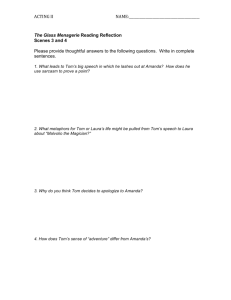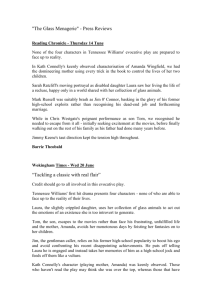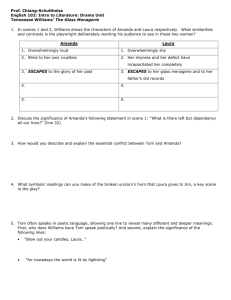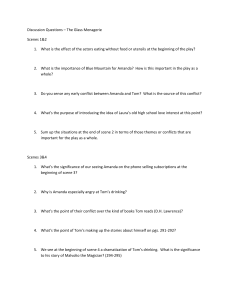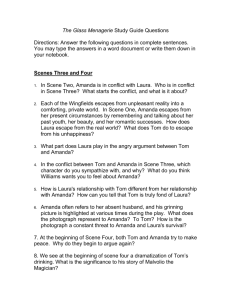Tennessee Williams was noted for writing lyrical
advertisement
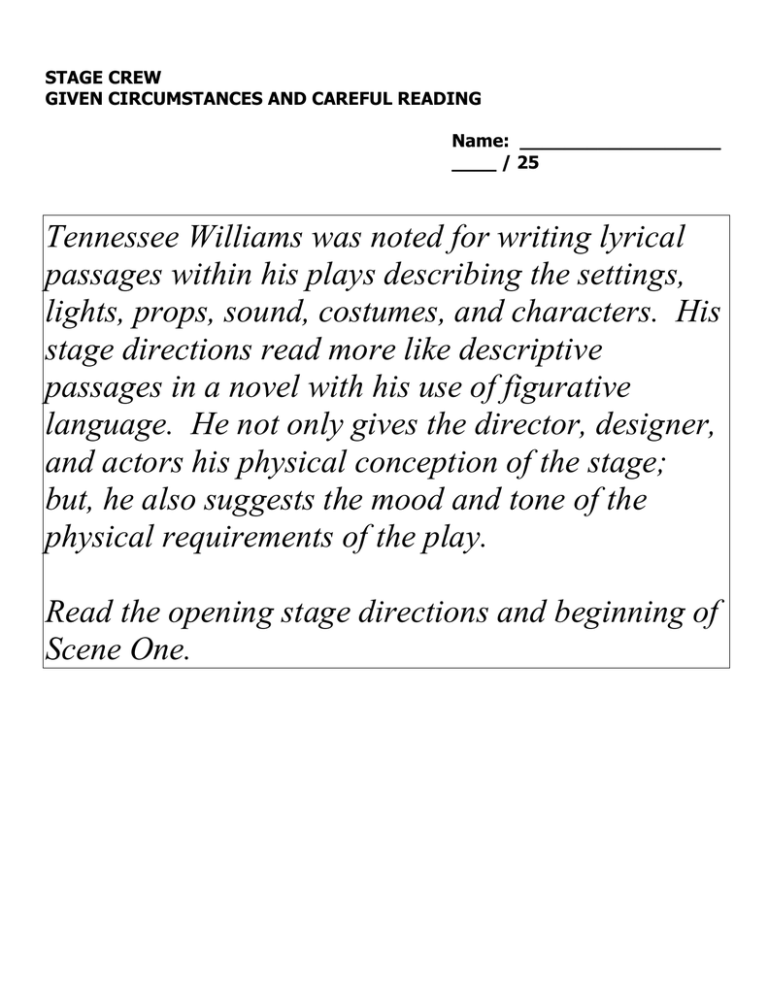
STAGE CREW GIVEN CIRCUMSTANCES AND CAREFUL READING Name: __________________ ____ / 25 Tennessee Williams was noted for writing lyrical passages within his plays describing the settings, lights, props, sound, costumes, and characters. His stage directions read more like descriptive passages in a novel with his use of figurative language. He not only gives the director, designer, and actors his physical conception of the stage; but, he also suggests the mood and tone of the physical requirements of the play. Read the opening stage directions and beginning of Scene One. The Glass Menagerie Part I: Preparation for a Gentleman Caller Scene One Tennessee Williams SCENE: The Wingfield apartment is in the rear of the building, one of those vast hive-like conglomerations of cellular livingunits that flower as warty growths in overcrowded urban centers of lower middle-class population and are symptomatic of the impulse of this largest and fundamentally enslaved section of American society to avoid fluidity and differentiation and to exist and function as one interfused mass of automatism. The apartment faces an alley and is entered by a fire escape, a structure whose name is a touch of accidental poetic truth, for all of these huge buildings are always burning with the slow and implacable fires of human desperation. The fire escape is included in the set – that is, the landing of it and steps descending from it. The scene is memory and is therefore nonrealistic. Memory takes a lot of poetic license. It omits some details; others are exaggerated, according to the emotional value of the articles it touches, for memory is seated predominantly in the heart. The interior is therefore rather dim and poetic. At the rise of the curtain, the audience is faced with the dark, grim rear wall of the Wingfield tenement. This building, which runs parallel to the footlights, is flanked on both sides by dark, narrow alleys which run into murky canyons of tangled clotheslines, garbage cans, and the sinister latticework of neighboring fire escapes. It is up and down these side alleys that exterior entrances and exits are made, during the play. At the end of TOM’S opening commentary, the dark tenement wall slowly reveals (by means of a transparency) the interior of the ground floor Wingfield apartment. Downstage is the living room, which also serves as a sleeping room for LAURA, the sofa unfolding to make her bed. Upstage, center, and divided by a wide arch or second proscenium with transparent fade portiere (or second curtain), is the dining room. In an old-fashioned what-not in the living room are seen scores of transparent glass animals. A blown up photograph of the father hangs on the wall of the living room, facing the audience, to the left of the archway. It is the face of a very handsome young man in a doughboy’s First World War cap. He is gallantly smiling, ineluctably smiling, as if to say, “I will be smiling forever . . .” The audience hears and sees the opening scene in the dining-room through both the transparent fourth wall of the building and the transparent gauze portieres of the dining-room arch. It is during this revealing scene that the fourth wall slowly ascends, out of sight. This transparent exterior wall is not brought down again until the very end of the play, during TOM’S final speech. The narrator is an undisguised convention of the play. He takes whatever license with dramatic convention is convenient for his purposes. TOM enters dressed as a merchant sailor from alley, stage left, and strolls across the front of the stage to the fire escape. There he stops and lights a cigarette. He addresses the audience. TOM: Yes, I have tricks in my pocket; I have things up my sleeve. But I am the opposite of a stage magician. He gives you illusion that has the appearance of truth. I give you truth in the pleasant disguise of illusion. To begin with, I turn back time. I reverse it to that quaint period, the thirties, when the huge middle class of America was matriculating in a school for the blind. Their eyes had failed them, or they had failed their eyes, and so they were having their fingers pressed forcibly down on the fiery Braille alphabet of a dissolving economy. In Spain there was revolution. Here there was only shouting and confusion. In Spain there was Guernica. Here there were disturbances of labor, sometimes pretty violent, in other wise peaceful cities such as Chicago, Cleveland, Saint Louis . . . This is the social background of the play. [Music] The play is memory. Being a memory play, it is dimly lighted, it is sentimental, is it not realistic. In memory everything seems to happen to music. That explains the fiddle in the wings. I am the narrator of the play, and also a character in it. The other characters are my mother, Amanda, my sister, Laura, and a gentleman caller who appears in the final scenes. He is the most realistic character in the play, being an emissary from a world of reality that we were somehow set apart from. But since I have a poet’s weakness for symbols, I am using this character also as a symbol; he is the long delayed but always expected something that we live for. There is a fifth character in the play who doesn’t appear except in the this larger-than-life-size photograph over the mantel. This is our father who left us a long time ago. He was a telephone man who fell in love with long distances; he gave up his job with the telephone company and skipped the light fantastic out of town . . . The last we heard of him was picture post-card from Mazatlan, on the Pacific coast of Mexico, containing a message of two words – “Hello—Good-bye!” and no address. I think the rest of the play will explain itself . . . [AMANDA’S voice becomes audible through the portieres] [TOM divides the portieres and enters the upstage area] [AMANDA and LAURA are seated at a drop-leaf table. Eating is indicated by gestures without food or utensils. AMANDA faces the audience, TOM and LAURA are seated in profile. The interior has lit up softly and through the scrim we see AMANDA and LAURA seated at the table in the upstage area.] AMANDA: [Calling] Tom! TOM: Yes, Mother. AMANDA: We can’t say grace until you TOM: come to the table! Coming, Mother. [He bows slightly and withdraws, reappearing a few moments later in his place at the table] AMANDA: [To her son] Honey, don’t push with your fingers. If you have . . . GIVEN CIRCUMSTANCES GRAPHIC ORGANIZER Name: _________________________________ Design Choice: _____________________________ Play: _________________________________ List a minimum of five (5) pieces of information under each column. QUESTIONS GIVEN CIRCUMSTANCES CREATIVITY 1. What is the MOOD of the piece? 2. What color palette comes to mind? 3. What are you trying to communicate with your design? 4. What is the OBJECTIVE of your design?
